Schnip's Trips: Spain, Pt. 1 🍽
From Madrid to the end of the Camino, we delight in superlative pastries, stunning seafood dishes, unparalleled pork plates and so much more
Back in May, we spent a little over two weeks traveling across Central and Northern Spain. (Yes, I am just now making time to write up the experience — how’s your busy summer been?) As always, food and drink adventures were among top priorities alongside museums, cathedrals and urban and natural destinations. We researched weeks ahead of time, departing with a 10-page lead sheet built around culinary items unique to each autonomous community (region) and city we planned to visit. We accomplished much of our goals, called plenty of audibles and discovered surprises along the way.
In the next few weeks, I’m documenting some of the highlights organized by our general chronological route. I’m aiming to let the photos do most of the heavy lifting, with some contextual commentary to fill in the short stories and perhaps act as a rough guidebook for you down the line. ’Nuff said. Let’s travel:
Madrid
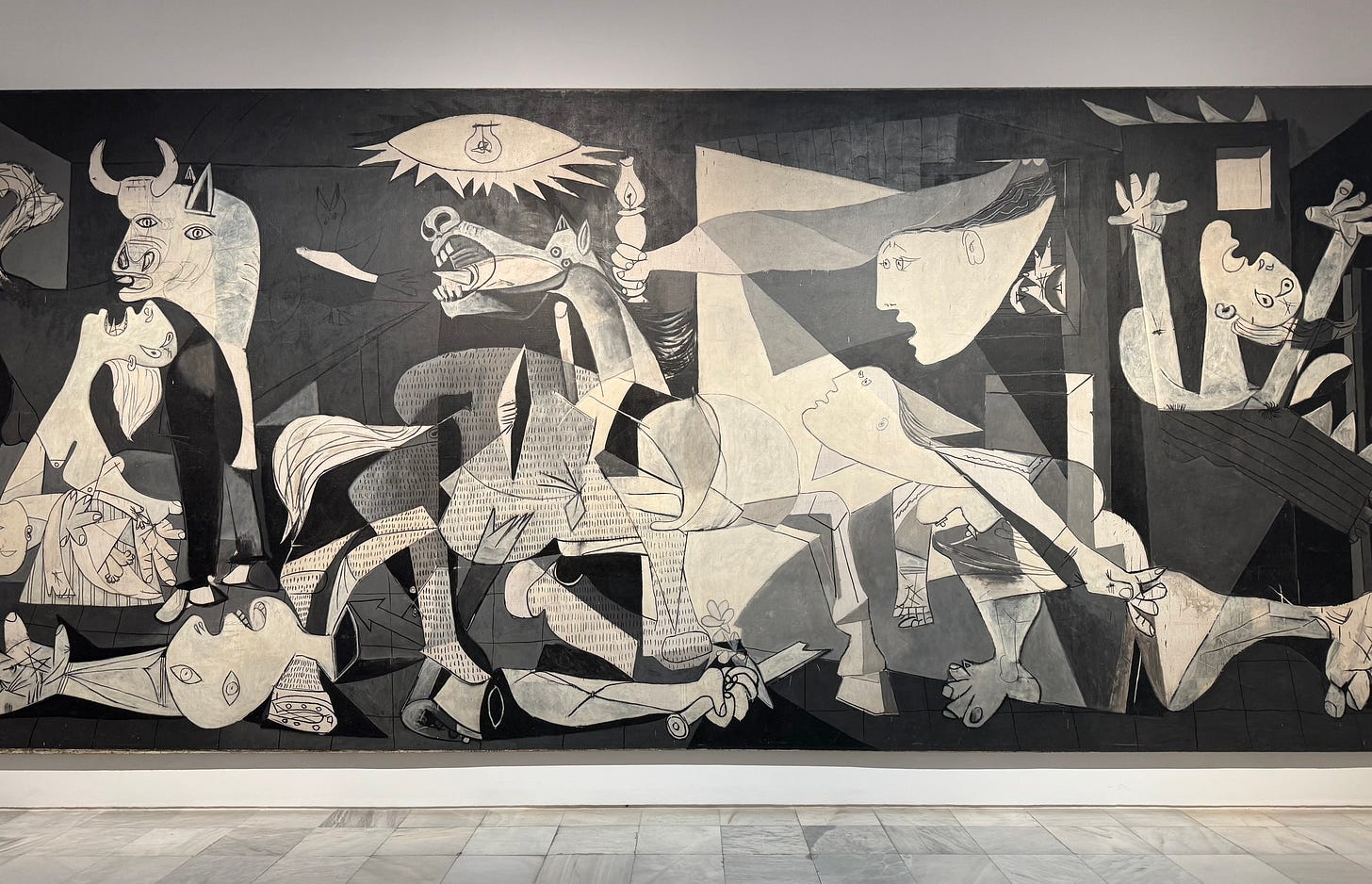
City market
Never say no to a food market when you find one. We hit the Mercado De San Miguel during evening hours on our first night in-country and elbow our way through narrow aisles next to vendors of all sorts. Among samplings, we nab a glass of Ribera del Duero wine, a skewer of mixed olives and a sampler of mini tortilla de patatas, called a Spanish omelette in larger format. Some things were prettier than they ended up tasting, but we had fun nonetheless.
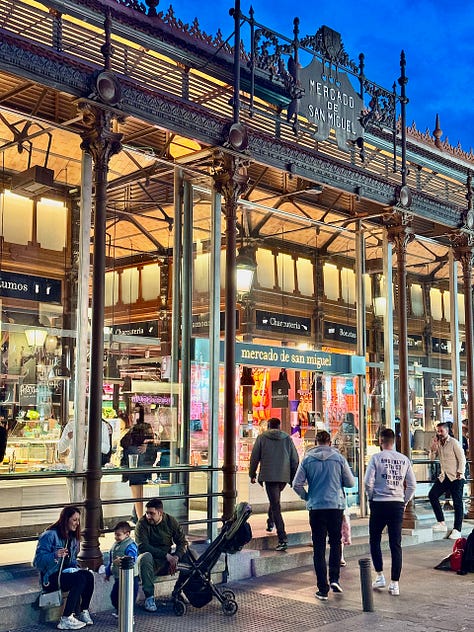
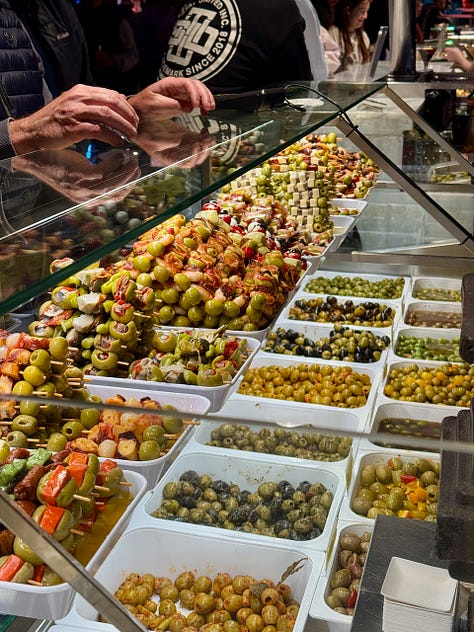
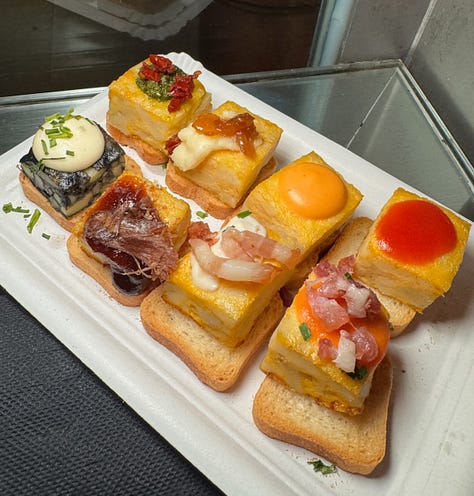
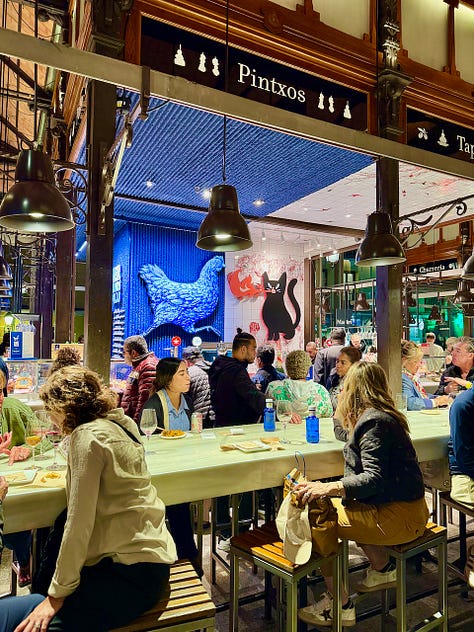
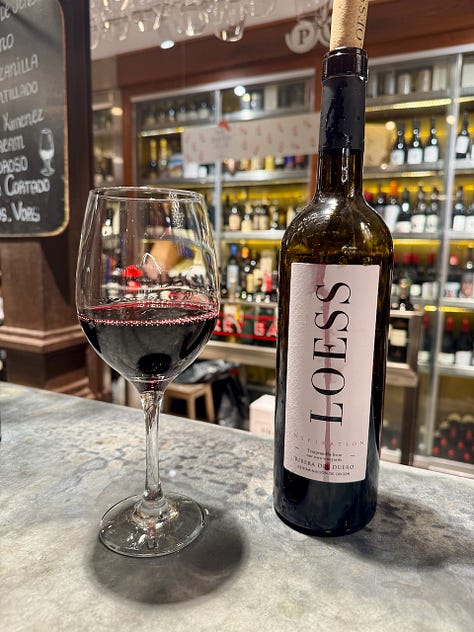
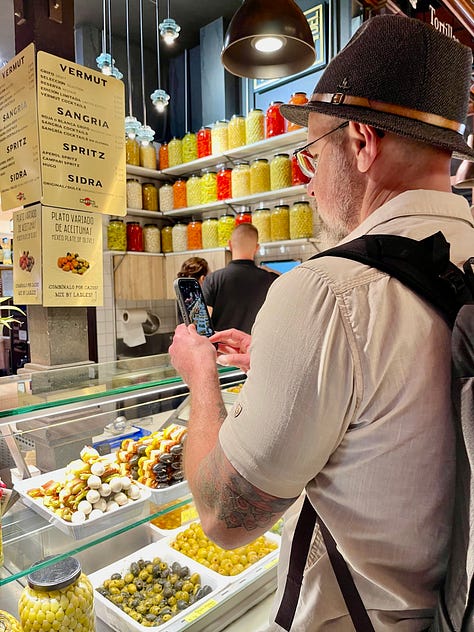
Tapas y pinchos
On another evening, we meet up with our friend Candace from the Springs, who’s coincidentally traveling at the same time. We create our own tapas crawl over beers and wines, ducking into a few sequential spots on a street named Plaza de Jesús near the giant El Retiro city park (thanks to legendary travel guide writer Rick Steves for pointing us there). Among the tapas and pinchos (small bites): various anchovies and tomato slices on toast (tostada de anchos); Iberico ham, smoked salmon and spicy tuna on soft rolls; chiporones (squid) wrapped in anchovies; and smoked tuna on baguette.
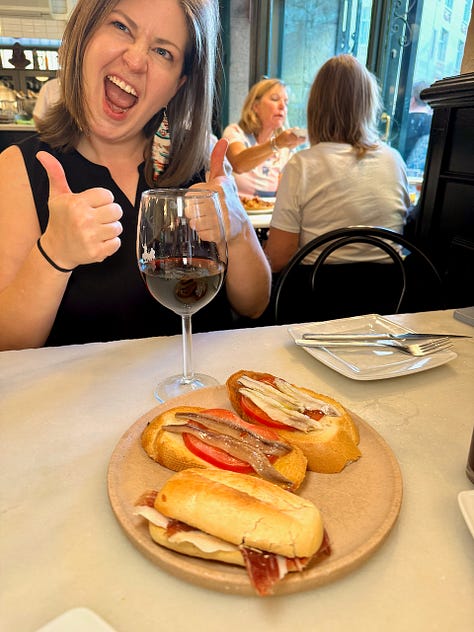
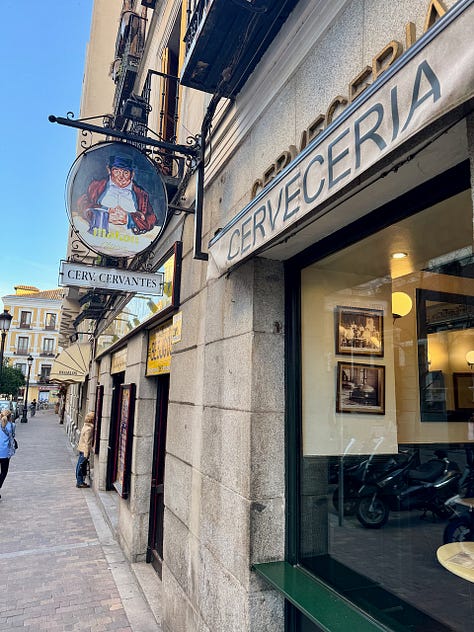
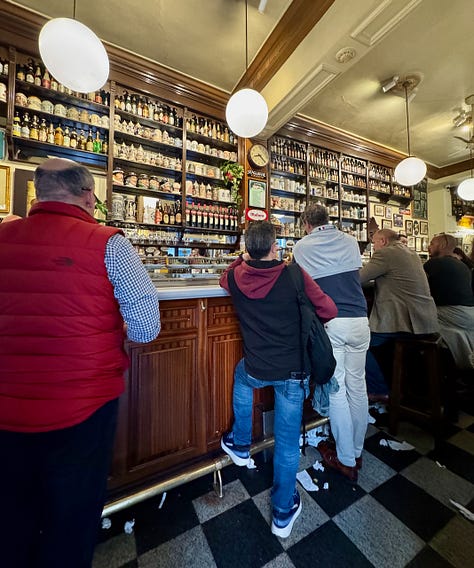
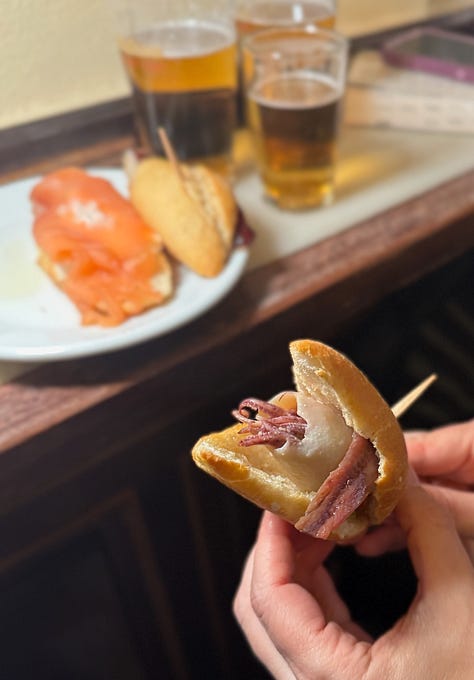
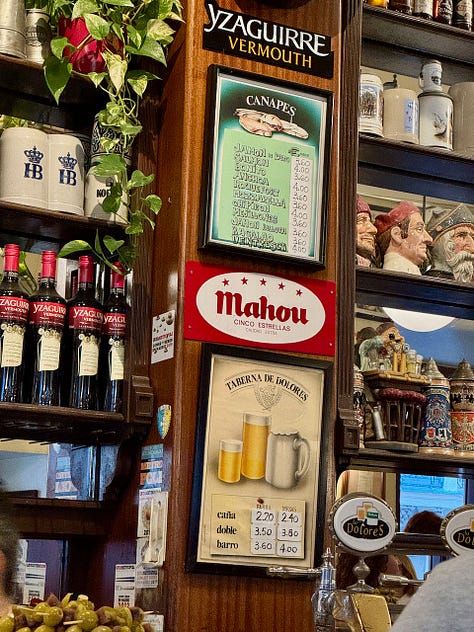
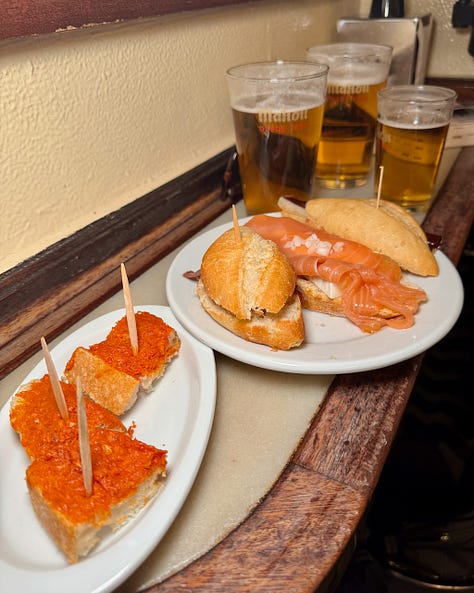
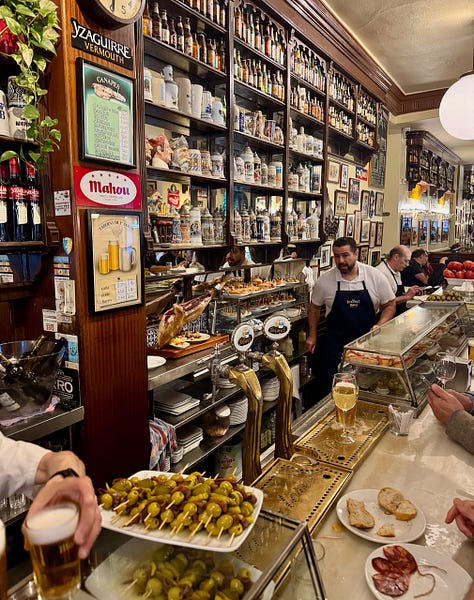
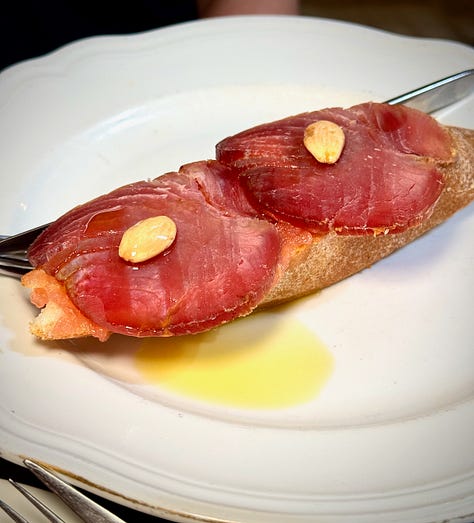
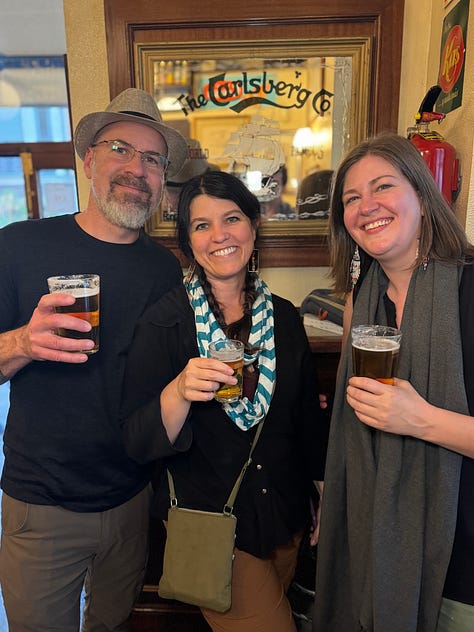
Nothing special to see here
Guidebooks and people will tell you that you need to try the bocadillo de calamares, “a quintessential Madrid treat” according to one online source. It’s a simple sandwich of lightly battered fried squid. The version I picked up had a drizzle of mayo sauce and the whole affair was utterly unremarkable, bland even. I can only assume there’s better versions out there and the one I stumbled upon was just a dud. I’m including the item in this highlight reel anyway, so perhaps you can find a superior bite.
An illicit drug deal with nuns
Okay, maybe that’s a little too racy of a headline, but that’s what the transaction feels like to exchange some euros for some sugar. Convent pastries are a thing across Spain, and the Monastery of Corpus Christi is famous with tourists for a variety of baked goods, including almond, orange or sherry shortbread biscuits (cookies). We’re only able to obtain a box of galletas, lemon-infused, crumbly and delightful. You put your money on the lazy susan-like wheel set into a wall in the monastery, and the nuns rotate it back to you with the good goods. You hear whispered voices behind the wall, but never see your dealer’s face. Despite being under the eyes of God and all, it feels clandestine. Whether that makes bites more sinful or sacred — you decide.
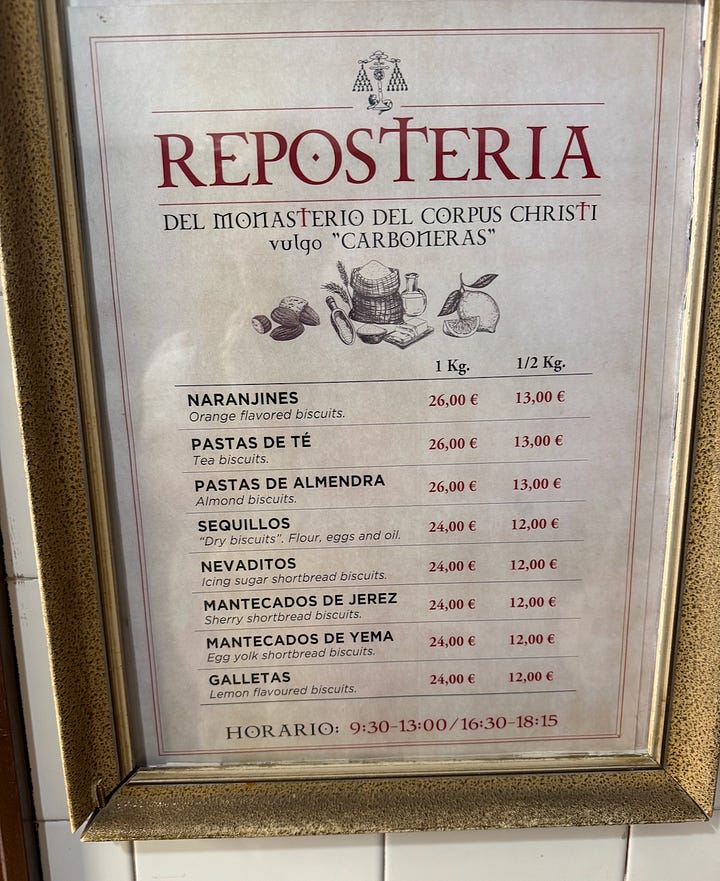
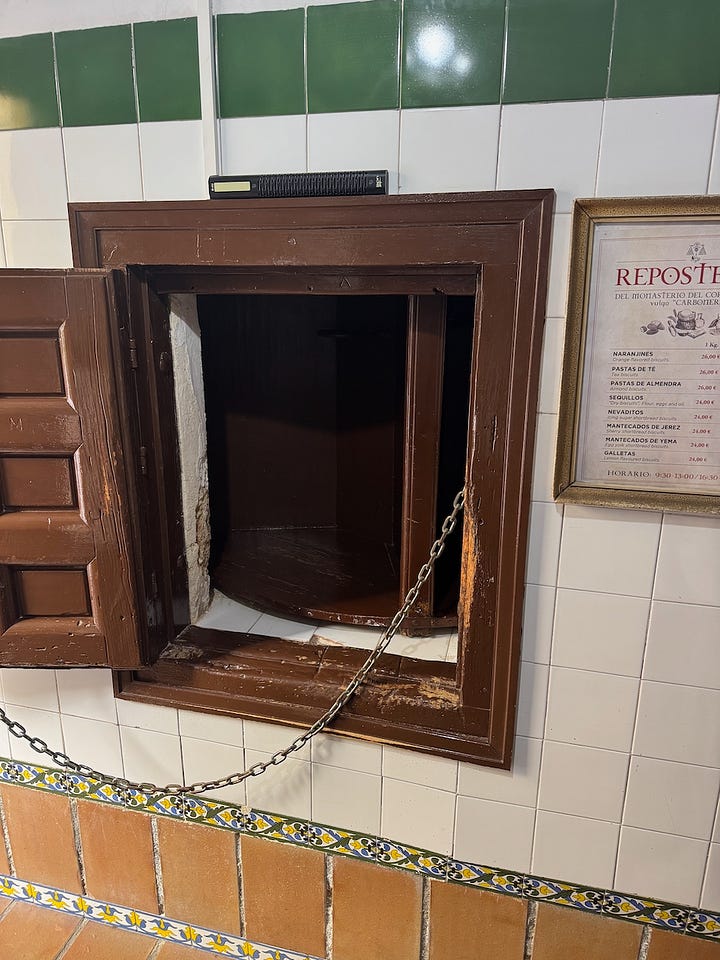
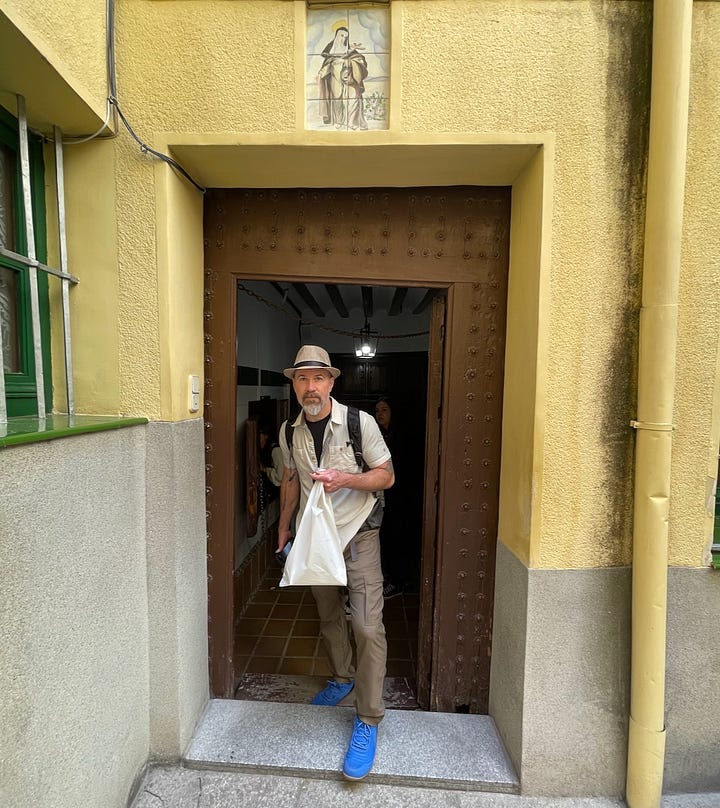
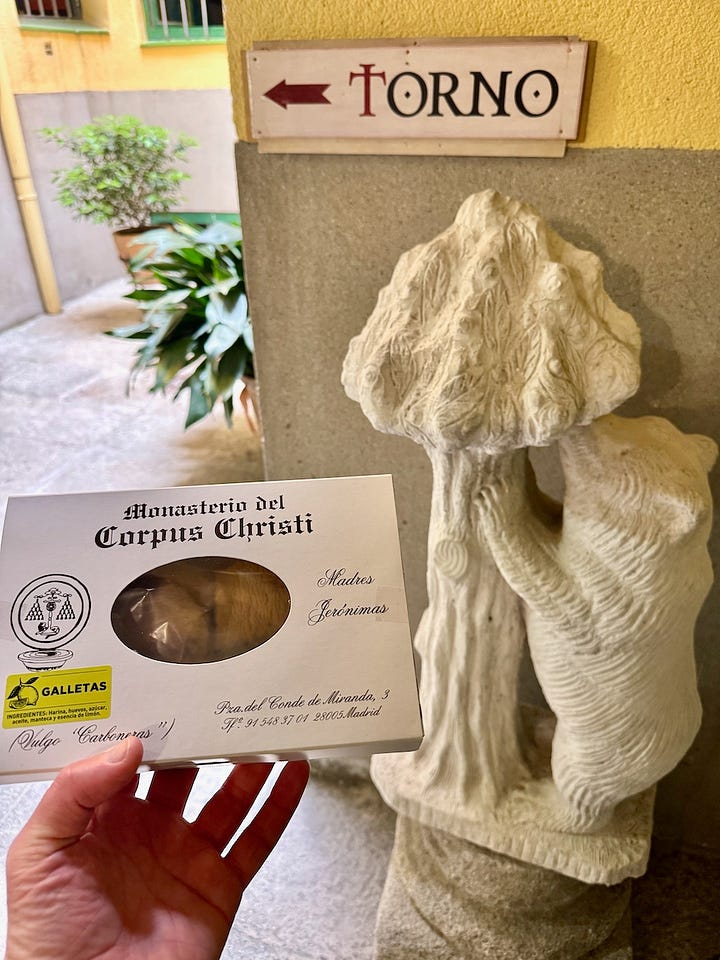
The bull bar
Though we’ll stop through Pamplona later in the trip, La Torre del Oro on Madrid’s Plaza Mayor is where you really come face-to-face with the bulls. Dedicated to bullfighting, and housing imposing taxidermy, it’s a mini museum complete with wall-to-wall historical photographs and memorabilia. Everyone from international presidents to dictators are pictured at the famous fights. We grab beers and an oxtail stew — totally on brand, obviously — and also put down some free gazpacho and paella samples given to us as complimentary dishes.
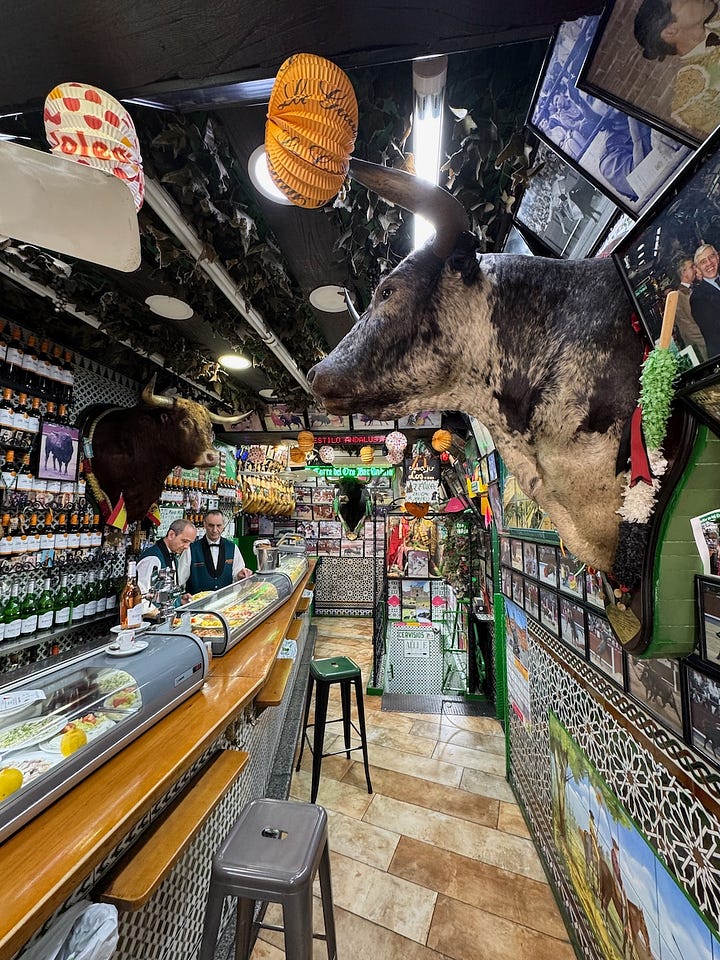
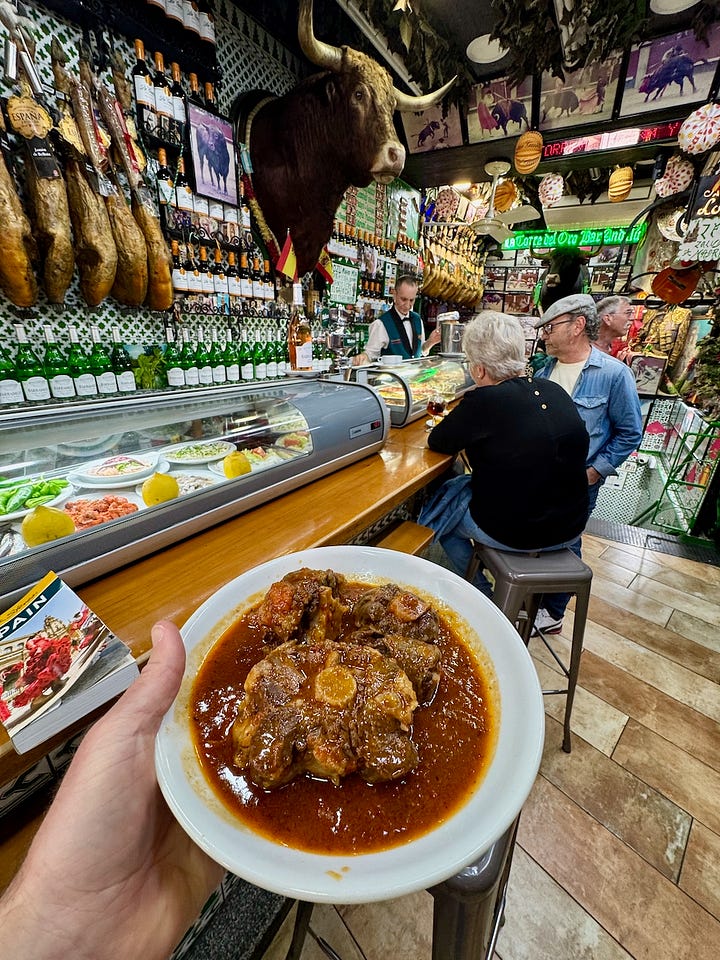
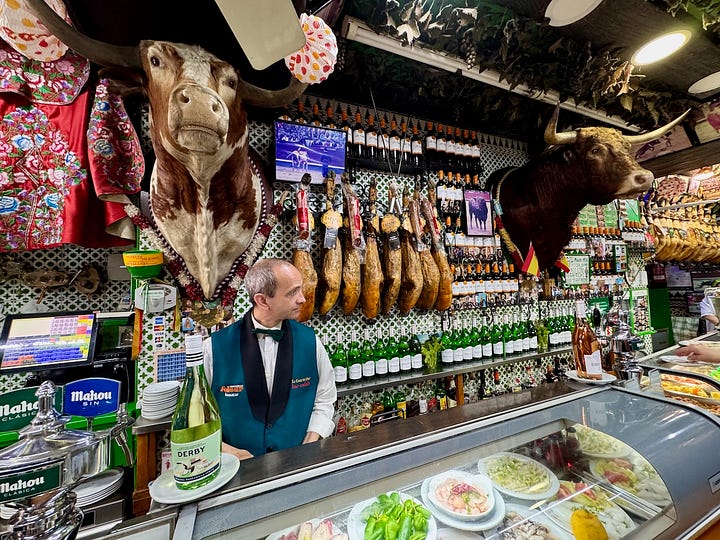
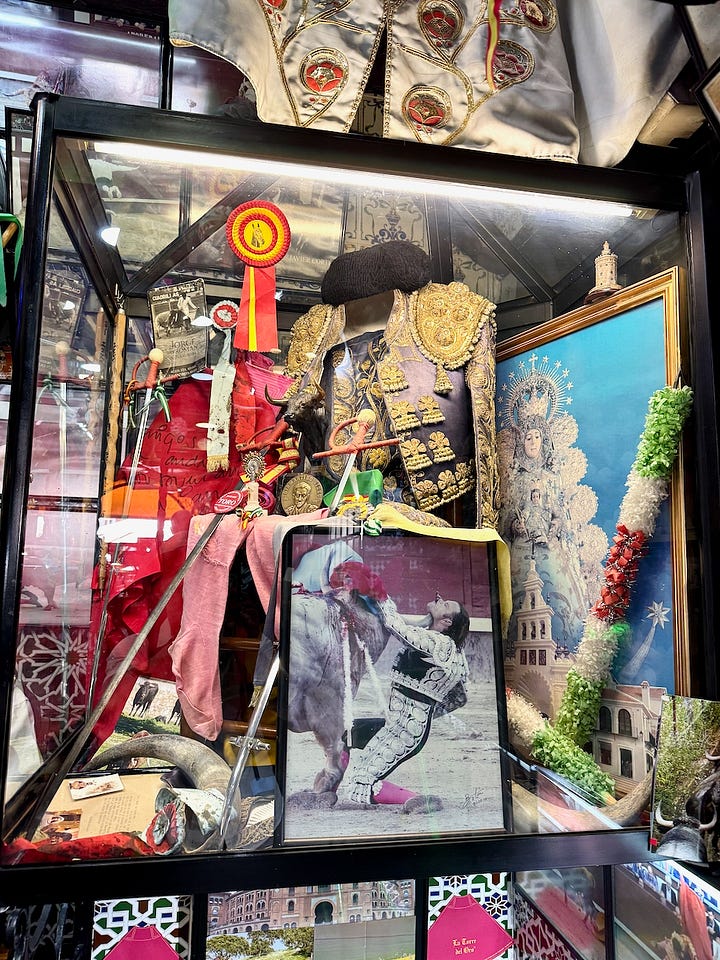
All the sweets
Of course we ducked into many pandaderias, pastelerias and reposterias (bakeries, cake and confectionary shops respectively) in Madrid and elsewhere during the trip. Something we indulged in more than once was the churros and chocolate phenomena, widely available but particularly famous at 120-year-old Chocolatería San Ginés. To dip into a thick, pudding-y drinking chocolate, you can get the familiar mini churros or larger porros, which are totally phallic (and only a small step away really from the penis pastries in Amarante, Portugal that we ate last year). Moving on, Lauren has a daily goal in Europe to always enjoy one croissant, and we peaked early in the trip by discovering a place called Pum Pum Bakery, motto “Sex, Drugs & Croissants.” Their pistachio croissant rellenos (filled with a sweet pistachio cream and topped in the crumbled nuts) are epic, and unforgettable.
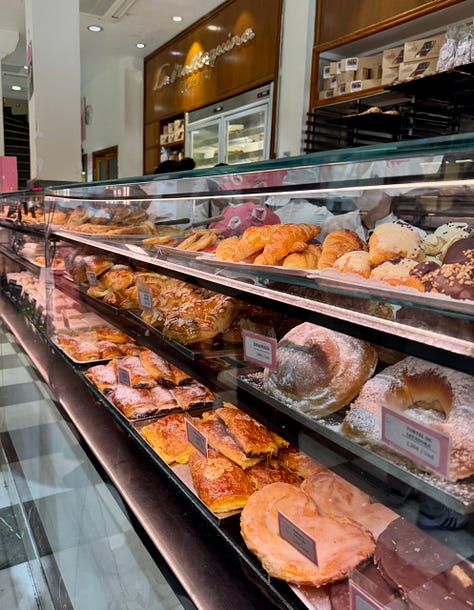
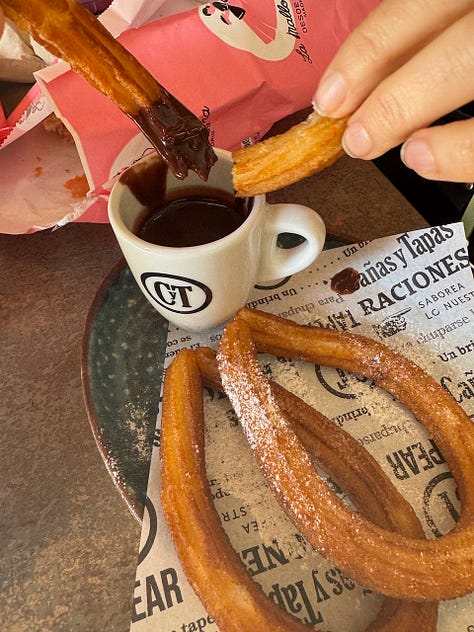
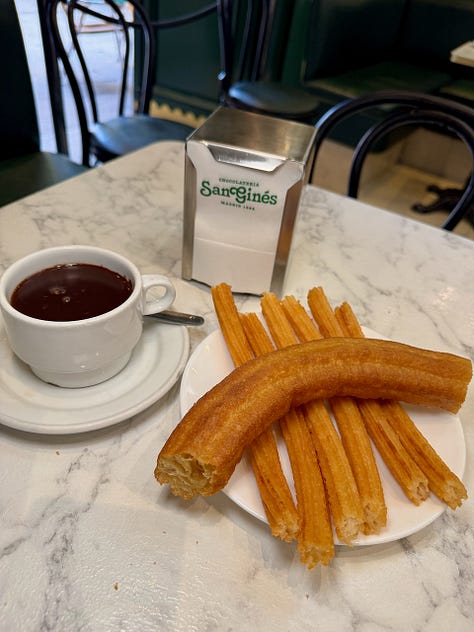
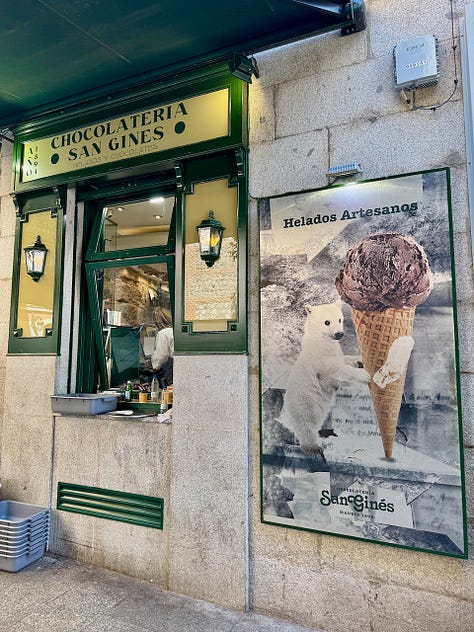
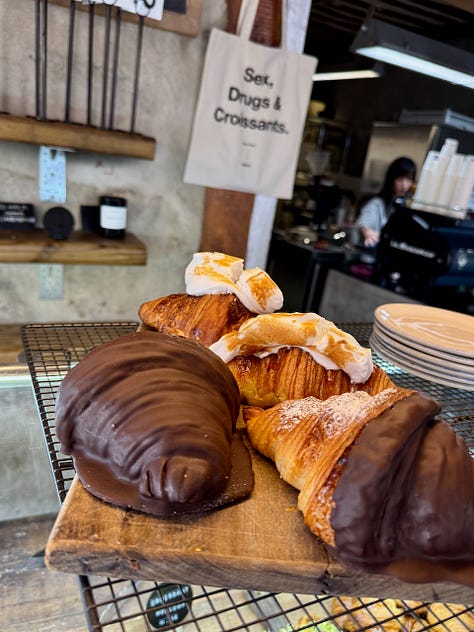
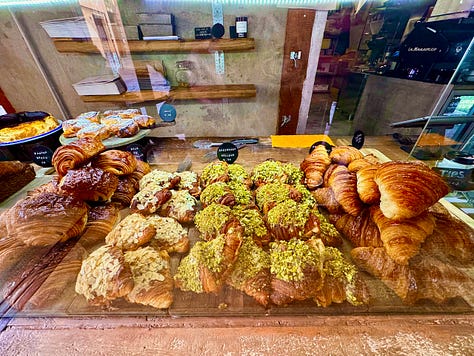
Toledo
If you head for a daytrip to Toledo from Madrid to see its stunning cathedral (perhaps the most impressive I’ve seen in all of Europe to date), plan to swing by the notable Santo Tomé Bakery for one of the pastries made with marzipan. Our lunch consisted of two hearty and satisfying items: a Russian salad with potato and tuna and the localized carcamusas pork stew in an oily, lightly spicy tomato sauce with a touch of sour acidity. With red wine, a light beer and a baguette hunk for dipping, this meal delivered everything we didn’t know we needed at that moment of rest between sights.
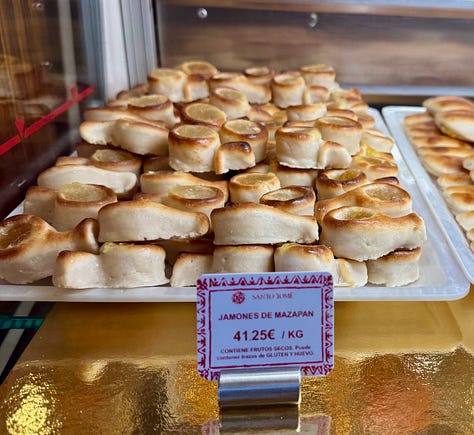
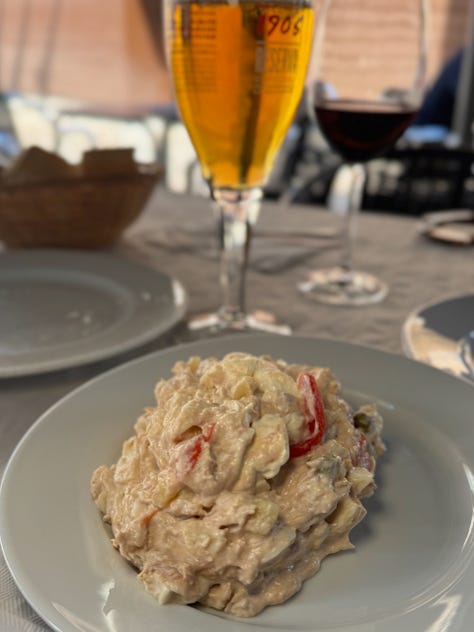
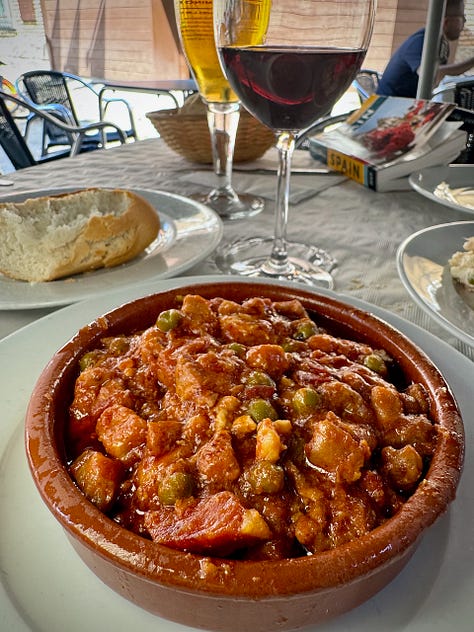


Segovia
The focus of our stop in this beautiful city, known for its nearly 2,000 year old, impressively preserved Roman aqueduct that runs through town, is the Michelin-recommended restaurant José María. Its specialty: roast suckling pig, part of the area’s cultural and culinary heritage (as the menu informs you). We go for the seven-course tasting menu (a relatively affordable $70 euro per person). It starts light with small bites of leeks and roasted bell peppers plus grilled zucchini in a cheese sauce with bacon crisps (a whiff of what’s to come). Then ham and bean stew with locally grown Judiones (large white beans), and an unctuous cod loin cut infused with bacon essence and garlic. Finally, the main attraction: Cochinillo de Segovia, suckling pig so obscene texturally that you’ll be ruined for pork for life. Its thick skin cracks like peanut brittle, audible to the tap of a fork, and the word “juicy” fails to fully describe the absolutely tender meat underneath. (New upscale dining categorization: swine dining. I pun!) Dessert was outstanding in its own way, with a Ponche de Segovia traditional layer cake with crème anglaise and nougat ice cream.

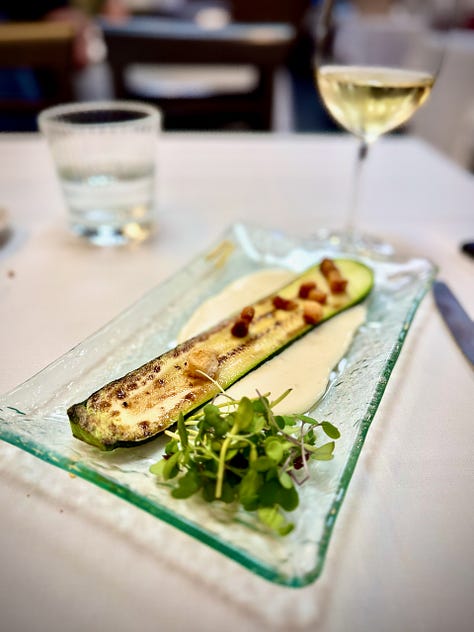
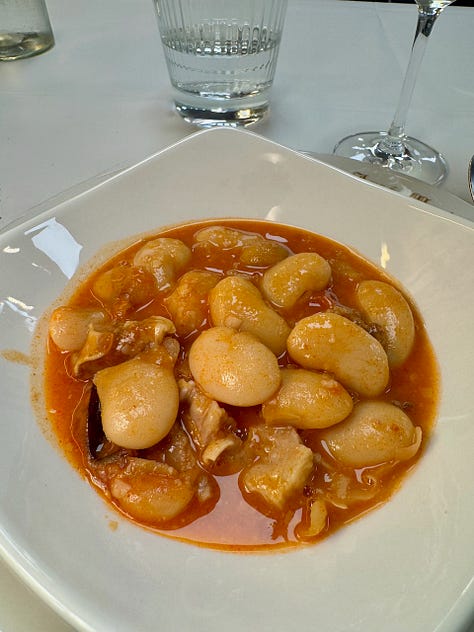
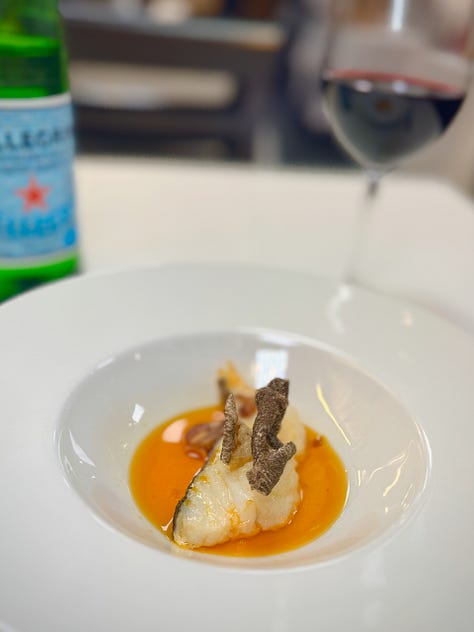
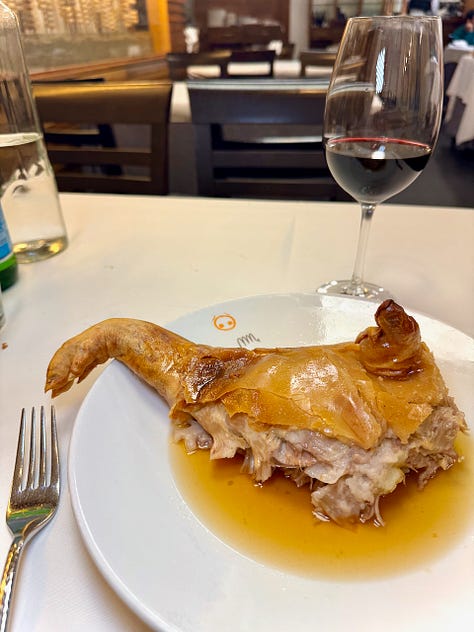
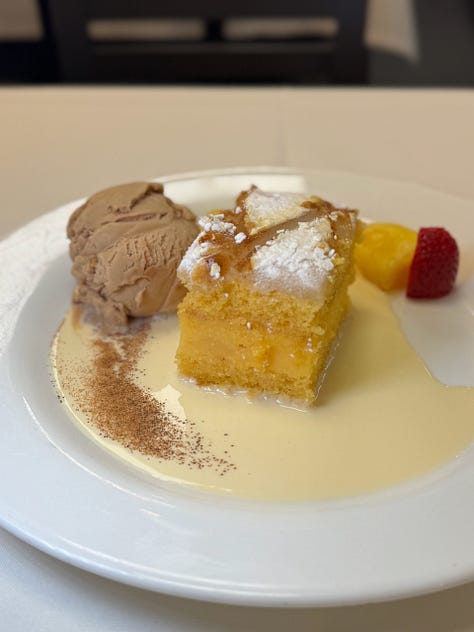
Salamanca
Located inside Salamanca’s Art Nouveau & Art Deco Museum is El Café de Lis, a colorful spot to grab some tea and coffee (or a boozy drink) thanks to the iconic stained glass windows that illuminate the space. Something to grab in the town that’s not found anywhere else is an awesome “meat pie” pastry called hornazo. (It supposedly has historic roots related to welcoming prostitutes back across the Tormes river after lent concluded.) Sandwiched in between wonderfully flaky and dense dough you’ll find lomo (marinated pork loin), chorizo and Spanish ham. Of all the pastries we had on the trip, I still think about this one. Another fine discovery was patatas meneás, which is mashed potatoes with paprika, bacon and chicharrón. Paired with beers: fabulous. Lastly, we sat at the bar at Michelin-awarded Taberna de Libreros (sans reservations) and dined on pinchos and sipped wine. Patatas con salsa brava de chipotle were like crispy home fries with a smoky, lightly plum-y, tart sauce. Gildas are a skewer of oily and punchy anchovies, green olives and pickled Guindilla peppers. And Champignones al Jerez are mushrooms in an herb and sherry broth, all combining for lovely umami and earthiness.
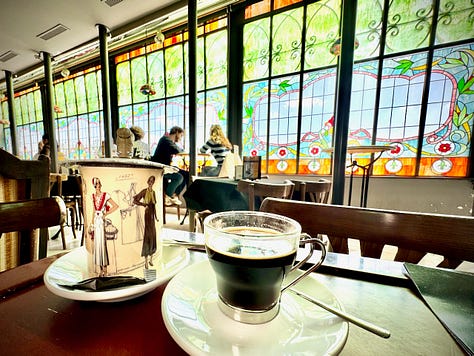
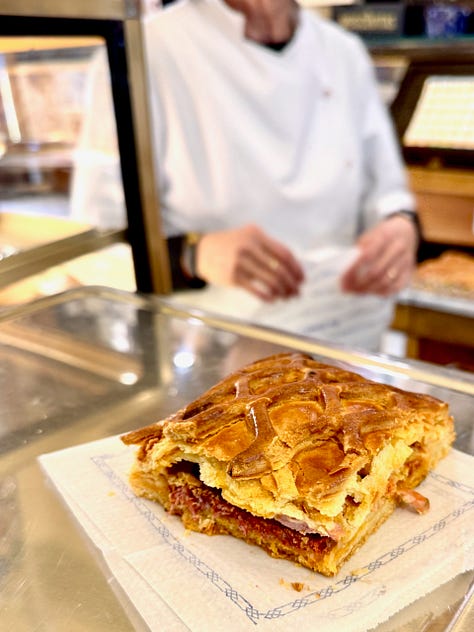
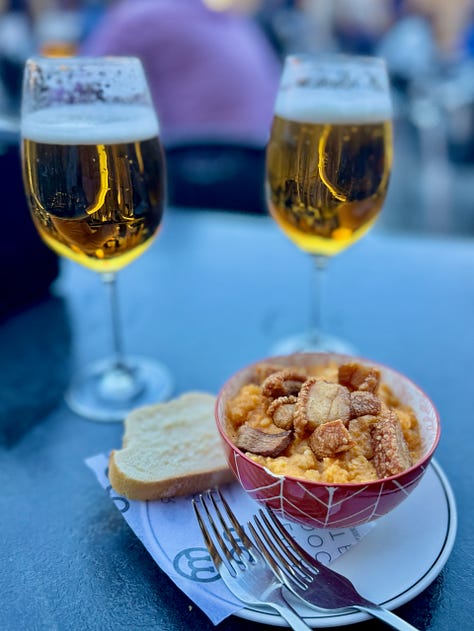
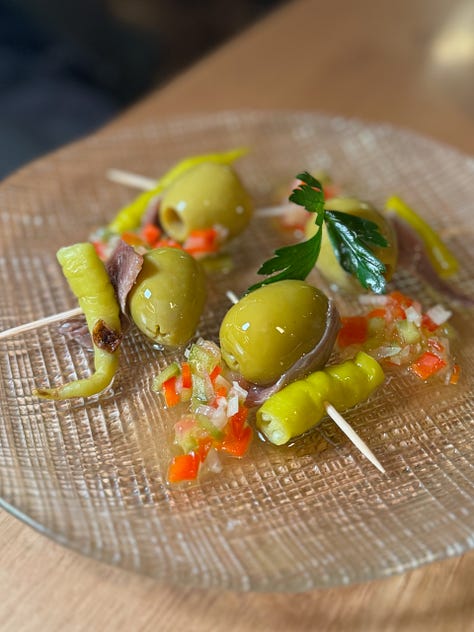
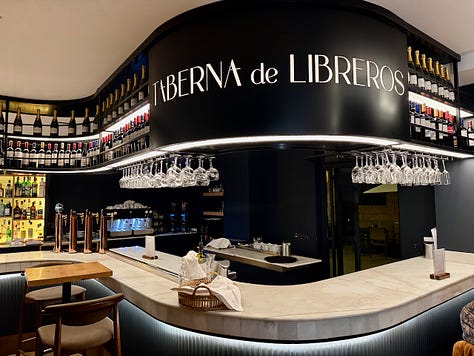
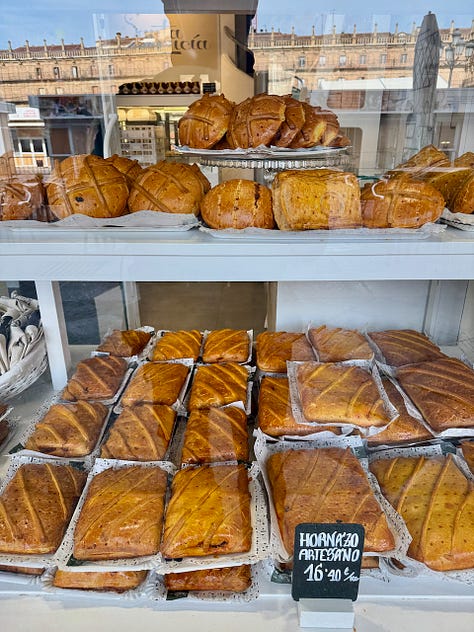
Vigo
We miss out on finding percebes (barnacles) as desired, but Lauren’s friends who live in the area do take us to a wonderful bar they frequent and buy us a fantastic spread of food. The pulpo y patatas photo at the top of this page was snapped during this meal, and that dish was one of the single most memorable of the whole trip. The octopus was the probably the softest and most tender I’ve ever had, seared and seasoned with olive oil and paprika. Those two ingredients informed several more dishes during the meal, including pork shoulder, pig ear (full of collagen and chewy) and octopus and cheese on toast, which proved less weird that it sounds and actually quite rich and good. Spanish croquetas (croquettes) were a fun starter with the local Estrella Galicia beer. And we were stunned by another dish named raxo, a Galician pork plate presented with thick-cut potato chips. The meat’s bursting with garlic flavor, and with a salty chip bite and beer sip the whole eating experience is comfort food bliss.
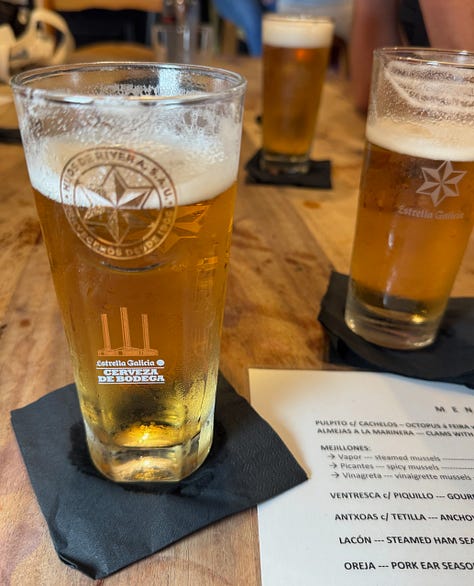
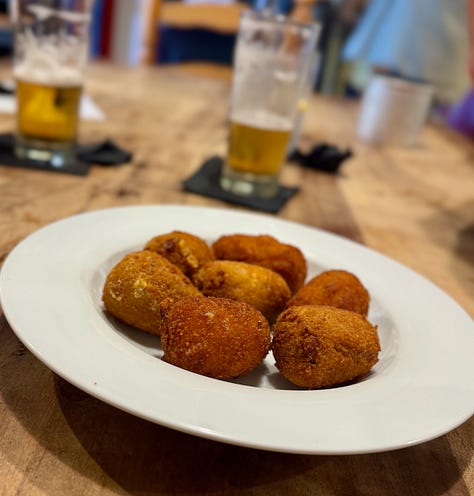
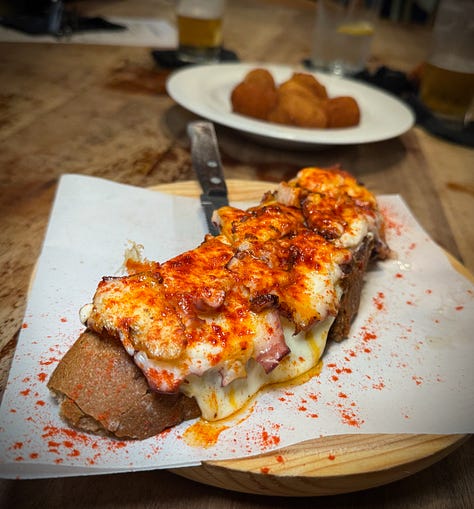
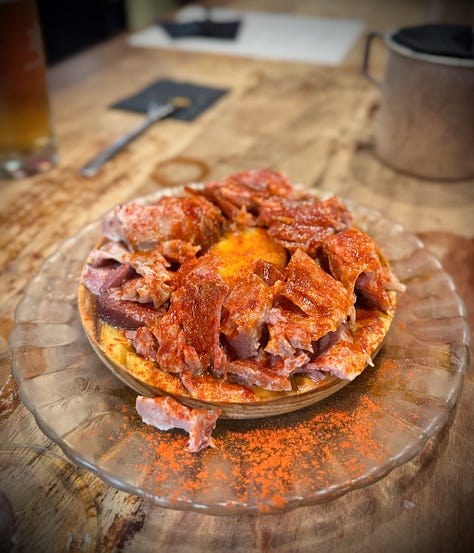
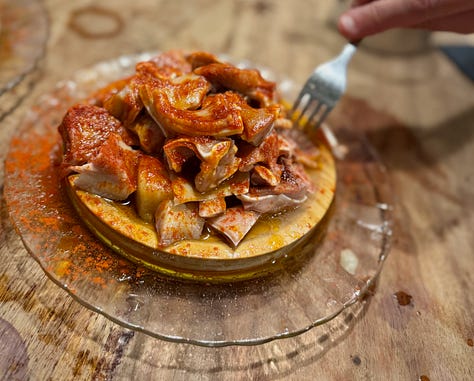
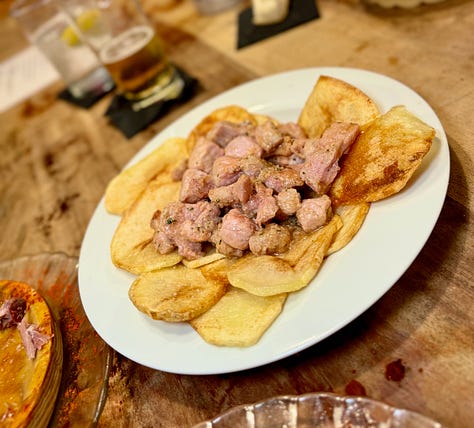
Santiago de Compostela
You know this town’s name because it’s where the Camino de Santiago pilgrimage trail through Spain concludes. We dropped by briefly and witnessed many of the ecstatic backpackers arriving in the cathedral square. Before departing, we nabbed a slice of Tarta de Santiago almond cake from a small cafe. It’s a simple, spongy and crumbly treat typically made with just egg, butter, sugar and almond meal, so it’s gluten-free. Definitely coffee friendly.
The bottle of Licor 43 with the Schnip sticker pictured below was actually part of a late night bar crawl we did with our friends before leaving Vigo. I asked for a Carajillo and the bartender didn’t know what it was, so I explained it to them and they indulged us, seemingly happy to learn a new-to-them drink. Naturally, I gifted them a sticker. I wasn’t expecting them to slap it right on the bottle, but I’m not complaining.
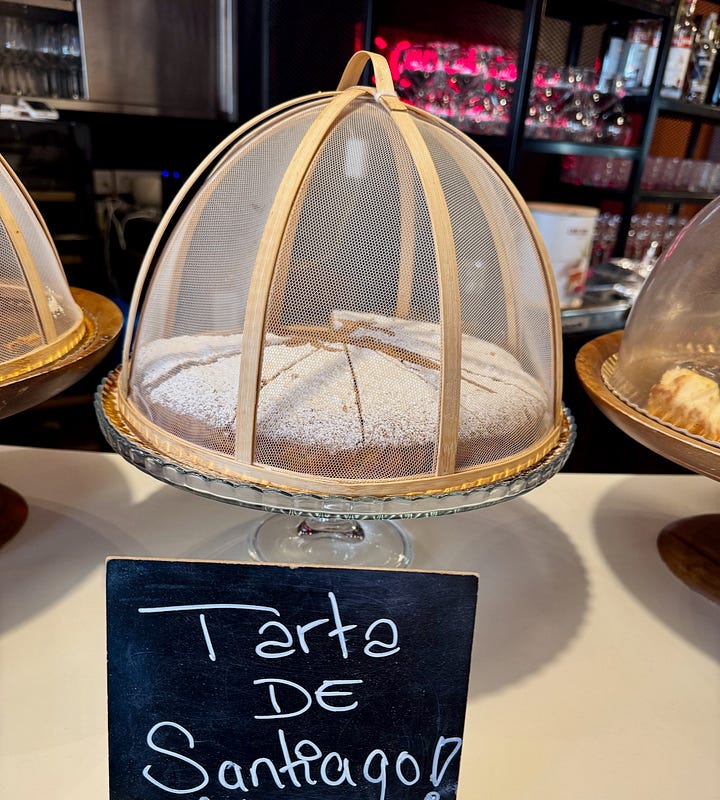
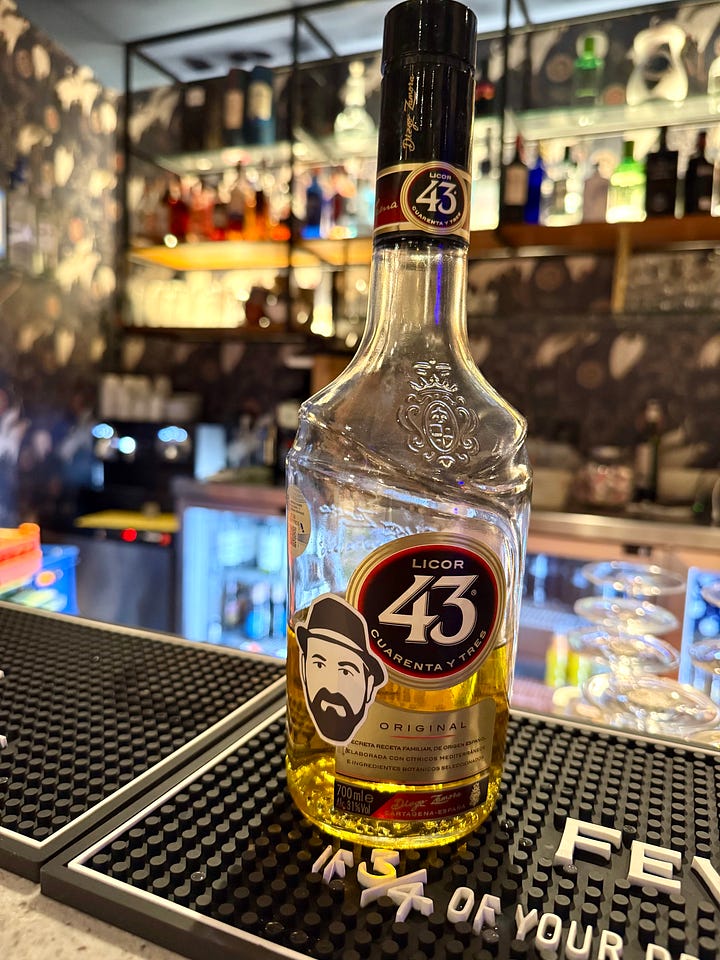

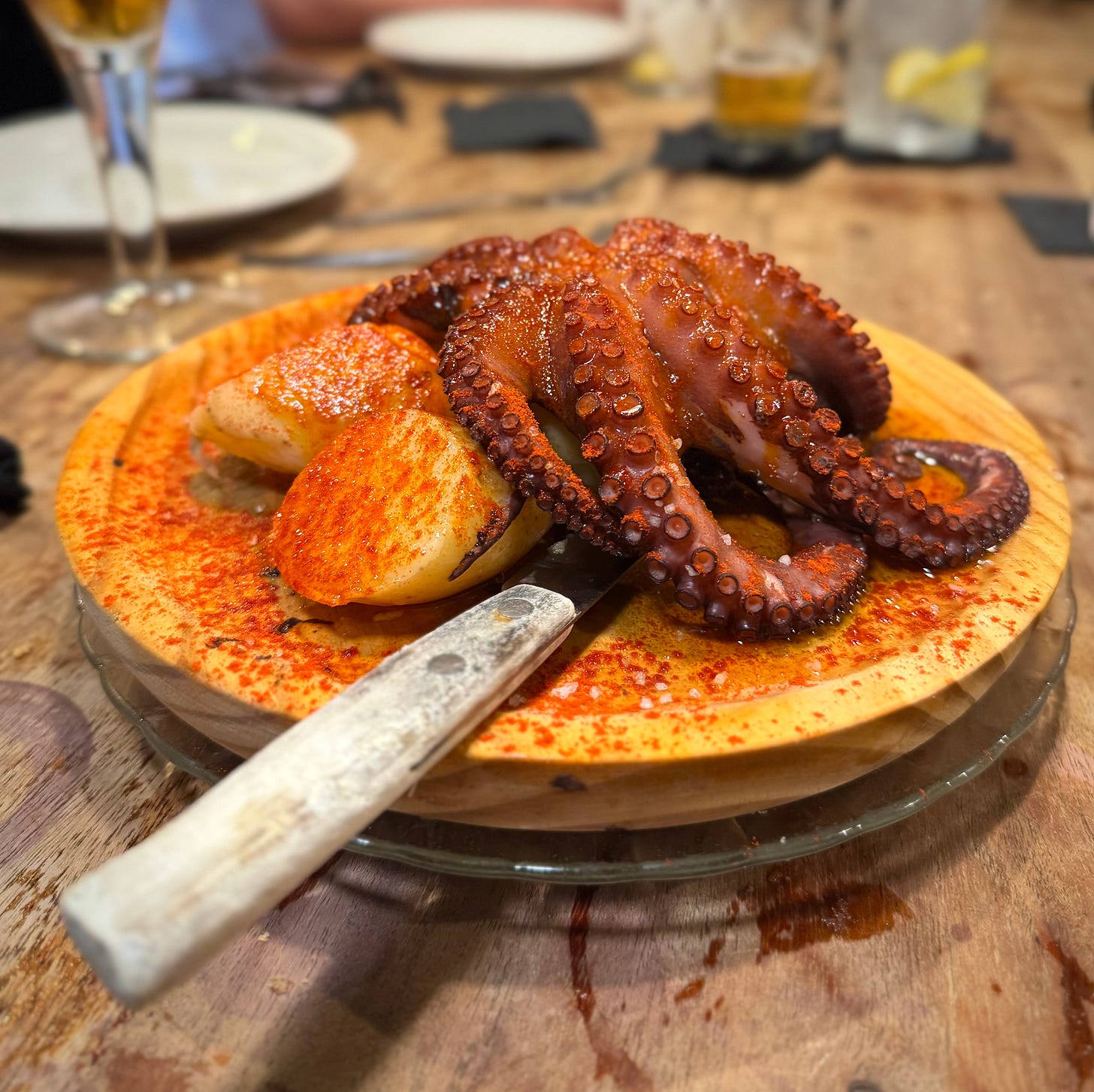
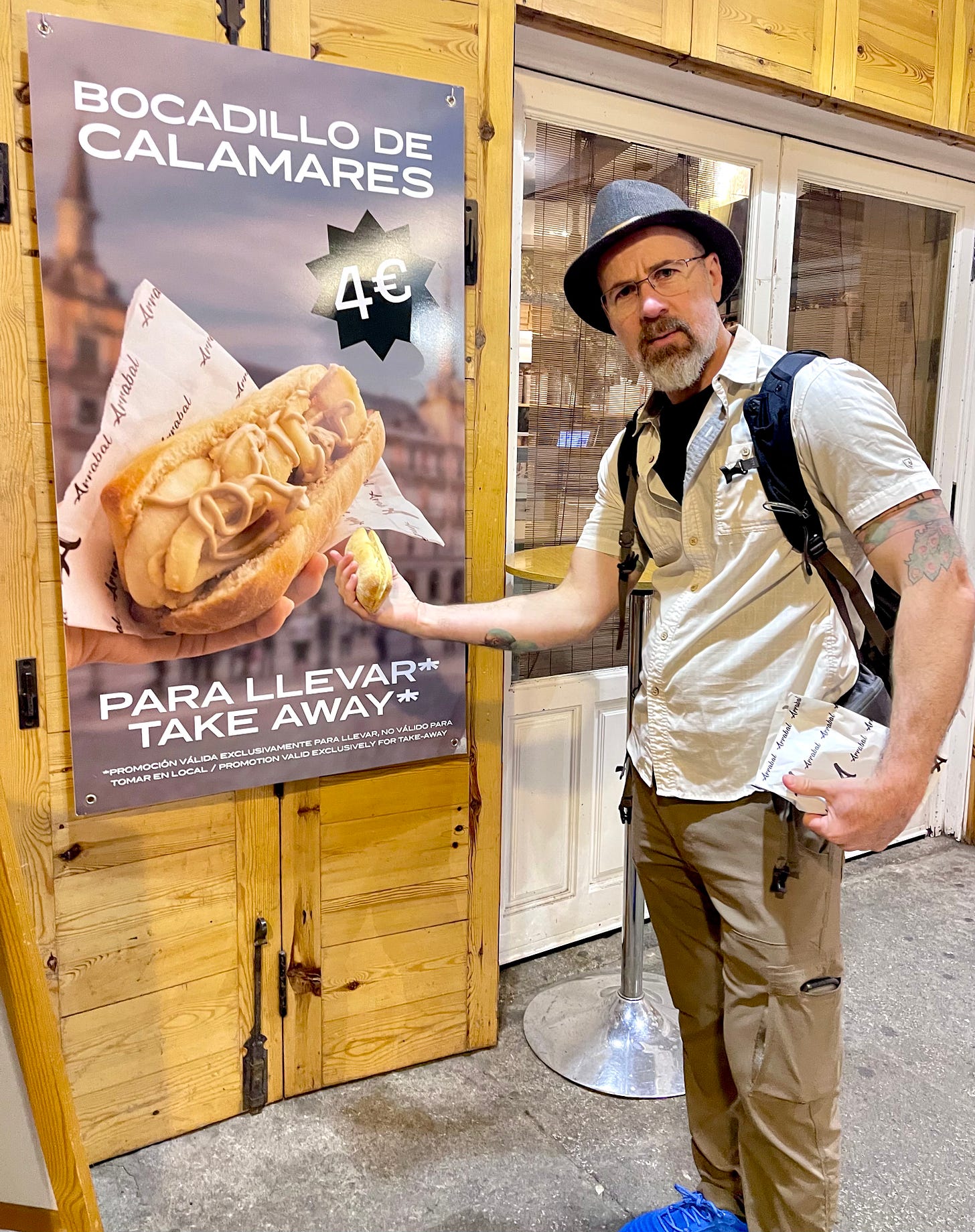
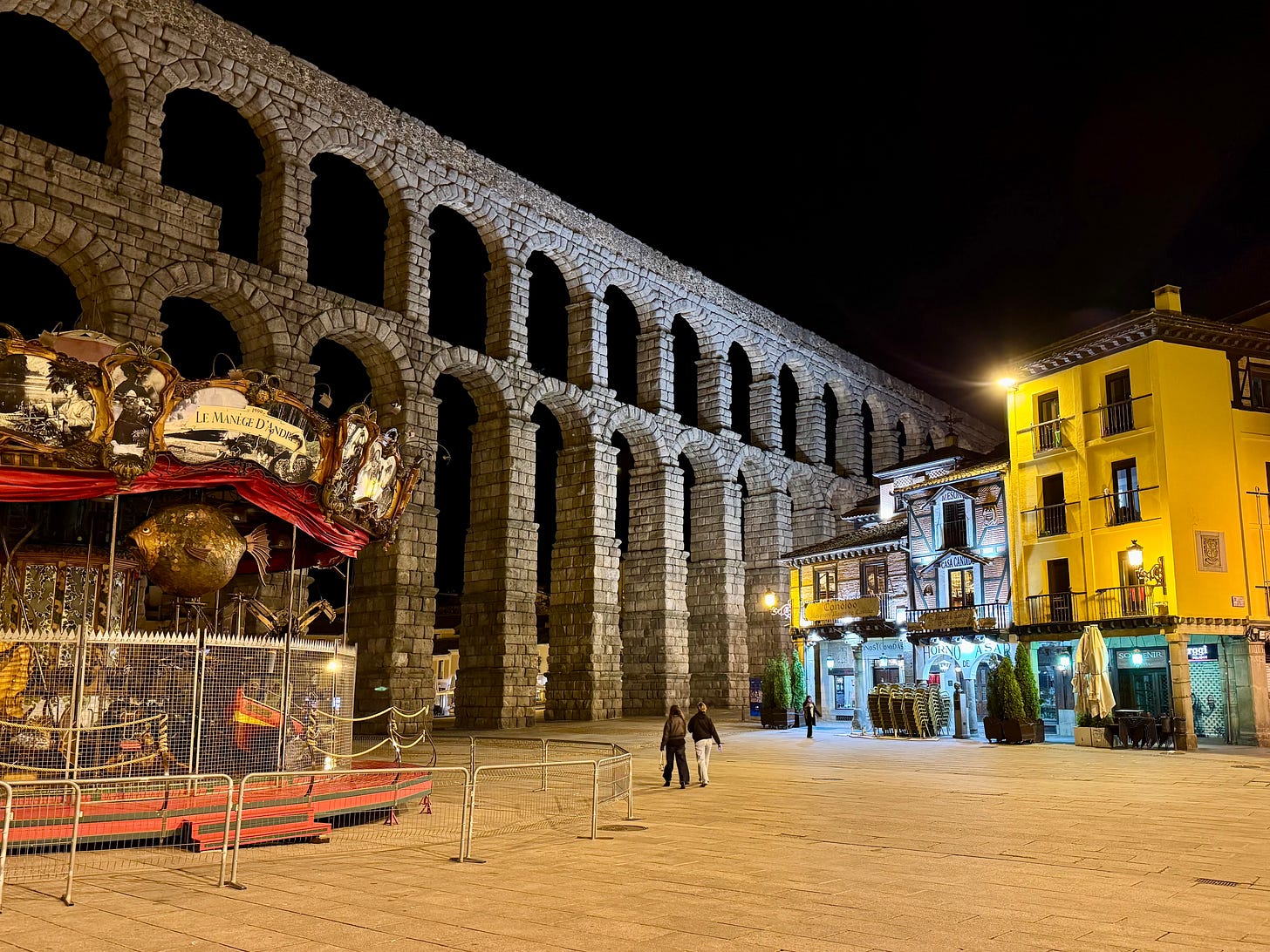
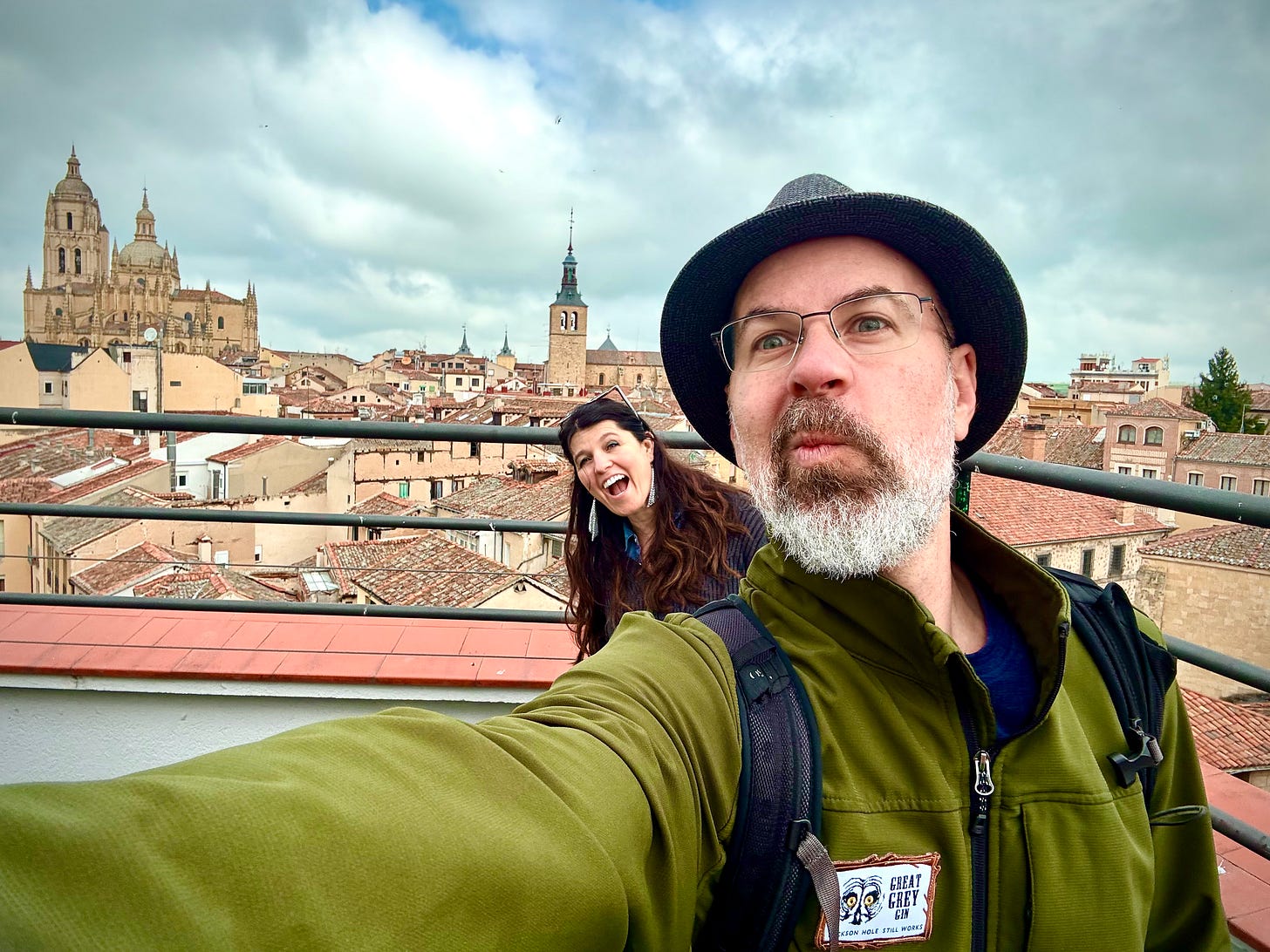
Oh. My. Gawd. We were waffling between Spain or Switzerland for our next trip to Europe, but you’ve sealed the deal for Spain. Can’t wait to see what’s in Part 2!